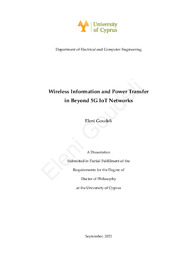Wireless Information and Power Transfer in Beyond 5G Networks

View/
Date
2022-09-02Author
Goudeli, EleniPublisher
Πανεπιστήμιο Κύπρου, Πολυτεχνική Σχολή / University of Cyprus, Faculty of EngineeringPlace of publication
CyprusGoogle Scholar check
Keyword(s):
Metadata
Show full item recordAbstract
In the new era of the Internet of Things (IoT) and wireless sensor networks, wireless power transfer (WPT) has been recognized as a promising technology to overcome the critical challenge of supplying power, remotely and wirelessly, to an extensive number of low-power IoT devices. Specifically, radio-frequency (RF) signals are considered as a viable source for WPT, since they have the ability to energize devices over a long distance, while are also used for wireless information transmission (WIT). This thesis deals with low-complexity information and power transfer techniques, applied over wireless information and power transfer (WIPT) technologies, such as backscatter and simultaneous WIPT (SWIPT), targeting to enhance the system’s performance.
As such, over traditional backscatter communication systems, we study a mul- tiple antenna topology and propose sophisticated spatial-modulation based tech- niques, exploiting space and time domain for transmitting information. Further- more, for SWIPT technology we study low-complexity energy detection schemes and propose solutions for an integrated SWIPT architecture. In this direction, we investigate the receiver’s and backscatter tag’s (BT) architecture, along with the rec- tifying circuits, decoding and energy harvesting (EH) models adopted, as means for further performance gains.
The proposed frameworks are provided to capture the systems’ enhancement in terms of error rate and EH. Specifically, the proposed topologies utilize tools from communication and signal processing theory, providing metrics, bounds and asymptotical results for a thorough performance analysis. Through the analysis, we draw insights about critical system parameters that affect the performance, such as the number of antennas/rectennas, the transmit power, the modulation scheme applied and the knowledge of the channel state information (CSI) at the receiver’s side.
Collections
Cite as
The following license files are associated with this item:

